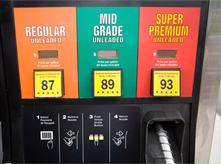What actually is octane? +VIDEO
 |
WASHINGTON - February 14, 2022: When most of us go to the gas station, we choose regular or premium gas without thinking too much about it. But in this video, we'll explore the science behind octane ratings and why it matters which one you put into your engine!
The American Chemical Society (ACS) is a nonprofit organization chartered by the U.S. Congress. ACS' mission is to advance the broader chemistry enterprise and its practitioners for the benefit of Earth and all its people. The Society is a global leader in promoting excellence in science education and providing access to chemistry-related information and research through its multiple research solutions, peer-reviewed journals, scientific conferences, eBooks and weekly news periodical Chemical & Engineering News. ACS journals are among the most cited, most trusted and most read within the scientific literature; however, ACS itself does not conduct chemical research. As a leader in scientific information solutions, its CAS division partners with global innovators to accelerate breakthroughs by curating, connecting and analyzing the world's scientific knowledge. ACS’ main offices are in Washington, D.C., and Columbus, Ohio.
What is octane?
In recent years, car manufacturers have been requiring or recommending premium gasoline (a high-octane grade of fuel) for use in more of their vehicle models. The difference in prices between premium and lower octane grades has also increased. As a result, more people are curious about what octane is and what those octane rating numbers on gas pumps mean.
Octane ratings are measures of fuel stability. These ratings are based on the pressure at which a fuel will spontaneously combust (auto-ignite) in a testing engine. The octane number is actually the simple average of two different octane rating methods—motor octane rating (MOR) and research octane rating (RON)—that differ primarily in the specifics of the operating conditions. The higher an octane number, the more stable the fuel. Retail gasoline stations in the United States sell three main grades of gasoline based on the octane level:
- Regular (the lowest octane fuel–generally 87)
- Midgrade (the middle range octane fuel–generally 89–90)
- Premium (the highest octane fuel–generally 91–94)
Some companies have different names for these grades of gasoline, such as unleaded, super, or super premium, but they all refer to the octane rating.
The large number on the yellow gasoline pump octane label is the minimum octane rating. (R+M)/2 Method on the label refers to the octane testing method used, where R is Research Octane Number and M is Motor Octane Number.
Of the 18 isomers of normal octane (C8H18), octane gets its name from the 2,2,4-Trimethylpentane compound, which is highly resistant to auto-ignition. This iso-octane has been assigned the reference value of 100 for testing purposes. The extremely unstable normal heptane (C7H16) molecule is the 0 octane reference fuel.
How does the octane level affect my vehicle?
Engines are designed to burn fuel in a controlled combustion. A flame starts at the spark plug and burns throughout the cylinder until all of the fuel in the cylinder is burned. In comparison, spontaneous combustion, also called auto-ignition, detonation, or knock, happens when rising temperature and pressure from the primary combustion causes unburned fuel to ignite. This uncontrolled secondary combustion causes pressure in the cylinder to spike and causes the knock to occur.
The competition between the intended (controlled) and unintended (spontaneous) combustion causes the energy from the burning fuel to disperse unevenly, which can cause damage and place high pressure on the engine's piston before it enters the power stroke (the part of the cycle when the piston's motion is generating power).






